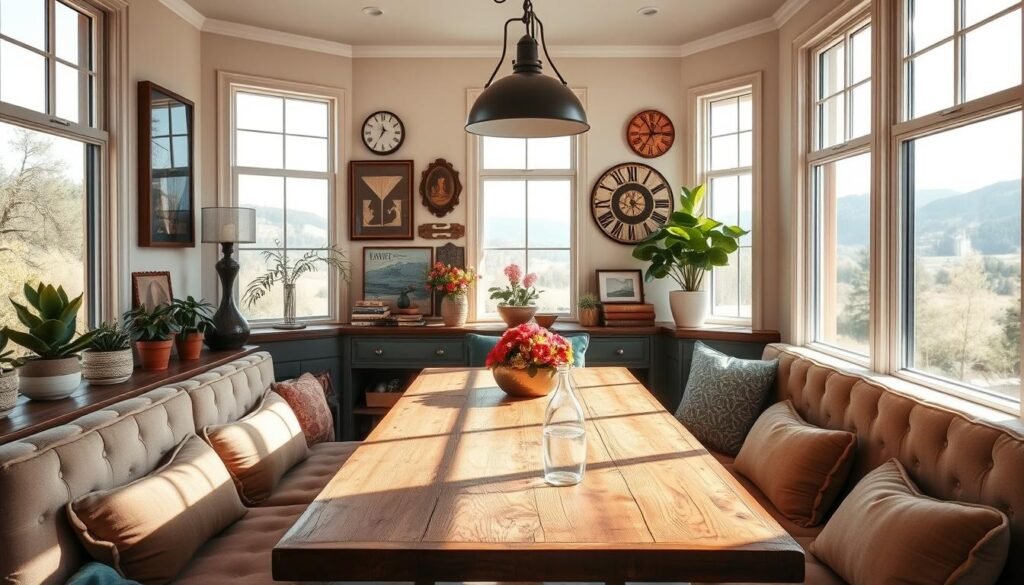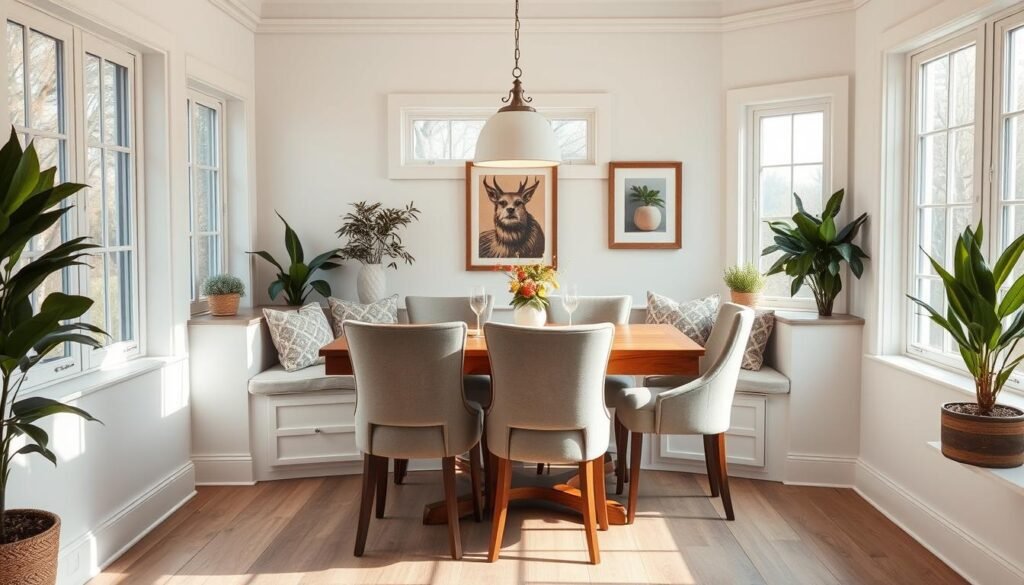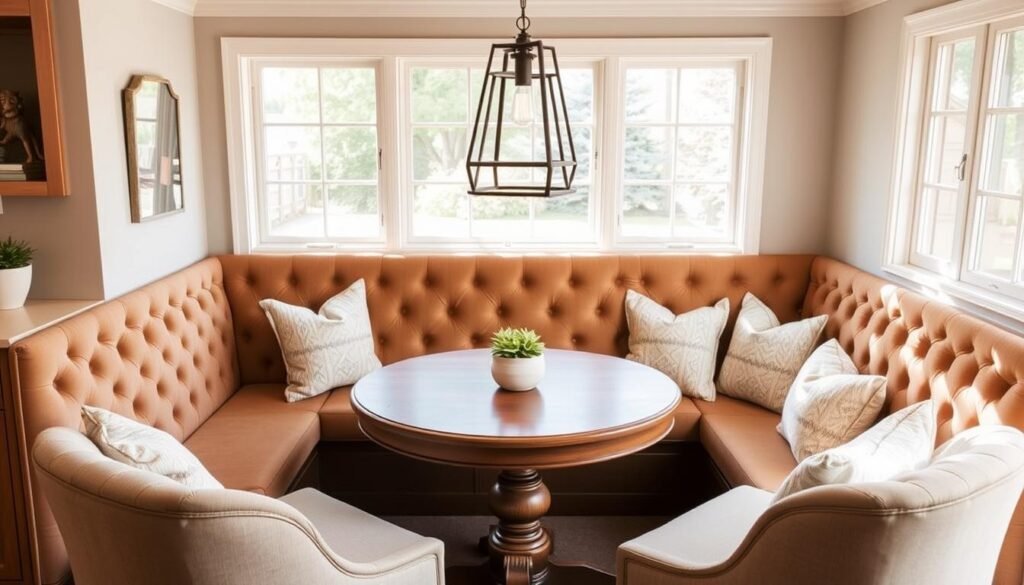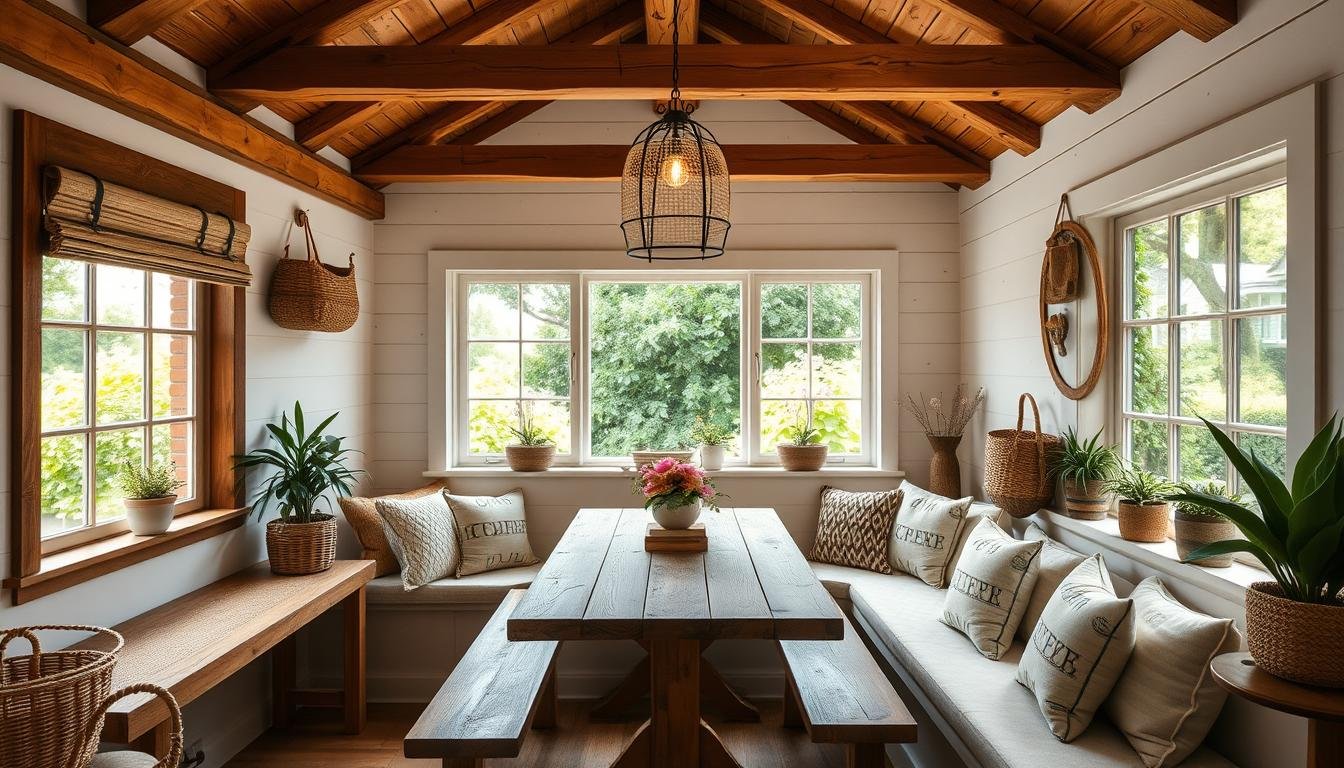This post may contain affiliate links. When you purchase through links on our site, we may earn an affiliate commission.
Did you know 78% of homeowners use their kitchen for more than cooking? This bustling hub now doubles as a workspace, homework station, and casual hangout spot. That’s why creating a cozy corner for daily routines isn’t just trendy—it’s essential for modern living.
Through years of redesigning kitchens, I’ve seen how the right seating area transforms how families connect. These spaces blend practicality with personality, turning cramped corners into cherished spots. Whether it’s your morning coffee ritual or a quick lunch between meetings, the magic lies in smart design choices.
I’ll walk you through every step—from measuring your space to choosing fabrics that survive pancake spills. You’ll learn how to mix textures, maximize storage, and create a vibe that feels uniquely yours. Even apartment dwellers can craft a mini oasis with clever solutions I’ve tested firsthand.
Key Takeaways
- Multipurpose areas boost functionality in modern kitchens
- Smart storage solutions maximize limited square footage
- Durable materials ensure longevity in high-traffic zones
- Lighting sets the mood for both productivity and relaxation
- Personalized decor creates emotional connections to the space
Setting the Scene for Your Breakfast Nook
Finding the right spot in your kitchen transforms overlooked corners into favorite family hubs. These intimate spaces thrive when they mirror how you actually live—not how magazines say you should.
https://www.youtube.com/watch?v=Qn3olQri9TU
Embracing a Cozy Corner in Your Home
I’ve transformed awkward kitchen spaces into functional gems by focusing on three elements: comfort, connection, and adaptability. Start by observing where people naturally pause—maybe near a sunny window or beside the coffee maker. That’s your golden opportunity zone.
One client’s 4-foot-wide alcove became their go-to spot for homework and weekend pancakes. We used a slim bench with hidden storage and weather-resistant cushions. The secret? Designing for real life—stain-resistant fabrics, easy-clean surfaces, and adjustable lighting.
Consider these when planning:
- Traffic patterns around your main workspace
- Morning light angles for vitamin D boosts
- Seating that tucks neatly against walls
Your nook should feel like a warm hug, not a staged photo. I often mix vintage chairs with modern tables—the contrast sparks conversation. Remember, this area isn’t just for eating. It’s where memories simmer alongside your afternoon brew.
Inspiration from Real-Life Breakfast Nook Designs
Some of the most captivating spaces emerge when designers dare to break rules. Let’s explore how professionals turn compact areas into style statements through fearless color play and curated art displays.

Design Spotlight: Statement Colors and Artwork
Rob Stuart’s work in a New Jersey home changed my perspective on chromatic confidence. His sunflower-yellow banquette transforms morning routines into joyful rituals. Paired with rattan accents, it whispers “coastal charm” without shouting beach clichés.
In Brookline, Cecilia Casagrande took boldness further. Her Hannah Banana-painted curved bench proves citrus hues belong in historic homes. “Color bridges eras,” she told me. “It makes heritage spaces feel alive.”
Real-World Examples from Leading Designers
Ward + Gray’s Manhattan project taught me about art curation. Their built-in seating frames Mike Perry’s vibrant painting like a museum exhibit. The result? A corner that sparks conversation before the coffee brews.
Tamsin Johnson’s genius lies in mixing opposites. Moody photography against striped cushions? A rattan table under modern sconces? She balances contrasts like a tightrope walker—effortlessly chic.
| Designer | Project Highlight | Key Feature | Style |
|---|---|---|---|
| Rob Stuart | Yellow banquette | Hidden drawers | Coastal modern |
| Ward + Gray | Art-focused seating | Gallery lighting | Urban eclectic |
| Cecilia Casagrande | Curved citrus bench | Ergonomic design | Historic revival |
| Tamsin Johnson | Mixed textures | Adjustable table | Transitional |
These spaces share a secret: personality trumps perfection. Whether through punchy hues or curated walls, they prove everyday corners deserve drama. Your turn to experiment—what story will your nook tell?
Key Elements of a Functional Breakfast Nook
Measurements make or break your cozy corner’s usability. Through trial and error with clients, I’ve discovered three non-negotiable elements: clearance, proportions, and traffic flow. Let’s turn your tape measure into a design superpower.

Layout and Flow Considerations
Start by marking 36 inches of clearance around your table’s edges. This golden rule prevents elbow bumps during pancake flips. For built-in benches, aim for 22-26″ depth—it’s the sweet spot between comfort and space savings.
Struggling to find the right table? Try these solutions:
- Convert entryway tables (29-30″ height)
- Use oval shapes for better legroom
- Position tables 12-14″ from bench seats
I recently transformed a galley kitchen’s dead-end into a sunny spot using a 30″ round table. The secret? Aligning it with the window’s sightlines while keeping the fridge path clear. Every inch matters when balancing meal prep zones with relaxation areas.
Observe your family’s natural pathways. Does the coffee maker route intersect with seating? Are backpacks dumped where stools should slide? Adjust your layout like a chess game—each piece should enhance daily rhythms without collisions.
Seating Solutions: Comfort and Smart Use of Space
Your morning coffee spot deserves seating that works as hard as you do. Through dozens of kitchen makeovers, I’ve found the perfect formula: cozy meets clever. Let’s explore options that turn cramped corners into inviting retreats.

Built-In Benches and Banquettes
Banquettes are my secret weapon for small areas. A recent project used a 6-foot bench with flip-up lids—suddenly, winter coats and board games had a home. “Storage shouldn’t sacrifice style,” says designer Mara Santos, whose navy velvet banquette became her client’s Instagram star.
Consider these when planning:
- 18-20″ seat depth for comfort
- Water-resistant fabrics for easy cleaning
- Angled corners to soften square rooms
Choosing the Right Chairs for a Casual Look
Freestanding chairs let you play with personality. I mix vintage ladderbacks with modern metal stools—the contrast feels lived-in, not chaotic. Danish cord seats add texture without bulk, perfect for tight spots.
| Seating Type | Best For | Key Features | Style Tip |
|---|---|---|---|
| Built-in banquette | Small spaces | Hidden storage | Use bold patterns |
| Mismatched chairs | Eclectic homes | Easy updates | Vary heights slightly |
| Counter stools | Open layouts | Space-saving | Add back cushions |
One client’s walnut chairs became conversation starters after we added sheepskin throws. Remember: Your seating should invite lingering, whether you’re scrolling emails or sharing pancakes.
Choosing the Right Table Size and Shape
Selecting the perfect table feels like matchmaking—it needs to harmonize with your space and lifestyle. I once helped a client repurpose her grandmother’s 32-inch gateleg table, proving great functionality often hides in unexpected places.
Round Versus Rectangular Options
Circular tops work magic in tight spots. Their curved edges create natural traffic flow—no bruised hips when squeezing past. A 36-inch diameter seats four comfortably, while 42-inch versions handle Sunday brunch crowds.
Rectangular designs shine in galley kitchens. They align with walls and window seats, maximizing legroom. For narrow areas, try a 24-inch wide table with bench seating. It’s surprising how much space you’ll save.
Benefits of Drop-Leaf Tables
These space-shifters adapt to daily needs. Keep one leaf down for coffee mornings, flip both up when neighbors pop by. I’ve sourced vintage models as slim as 18 inches wide—perfect for studio apartments.
Can’t find small enough options? Hunt for entryway tables at 29-30” height. Pair with counter stools for casual dining zones. One client’s $15 flea market find became her favorite homework station.
Storage Solutions to Maximize Your Space
Smart storage turns cramped corners into functional gems. My clients often share the same challenge: keeping essentials accessible without visual chaos. The solution lies in strategic hidden compartments and vertical displays.
Under-Bench and Lift-Up Storage Ideas
Built-in seating becomes a storage powerhouse with lift-up lids. Unlike drawers that fight with knees, these hinged tops reveal deep compartments perfect for seasonal items. I recently designed a bench holding six board games and a picnic basket—all invisible when closed.
Consider these for your lift-up system:
- Gas struts for smooth opening
- Felt-lined interiors to prevent scratches
- Waterproof lining for spill-prone zones
Floating Shelves and Slim Sideboards
Vertical storage keeps floors clear. I install floating shelves 18″ above benches—ideal height for grabbing coffee mugs while seated. One client’s 10-inch deep shelf holds their entire mug collection plus recipe books.
Slim sideboards under 12″ depth work magic in tight spots. Look for models with:
- Adjustable glass doors
- Integrated charging stations
- Heat-resistant countertops
Remember: Every inch should serve multiple purposes. Your storage shouldn’t just hold stuff—it should simplify daily routines.
Lighting Ideas for a Cozy Nook
Lighting transforms your space from functional to magical with just a flip of a switch. Through years of designing intimate corners, I’ve learned illumination does more than brighten—it shapes how we feel in a room. The right mix creates warmth that invites lingering conversations and quiet moments alike.
Pendant Lights, Chandeliers, and Sconces
Pendant lights reign supreme for good reason. Their focused glow draws people together like campfire light. I recently hung a trio of milk-glass pendants above a client’s table—their soft diffusion turned harsh mornings into serene starts.
Don’t overlook wall sconces. These space-savers add ambient lighting without eating table real estate. Pair them with dimmers to shift from energizing breakfasts to relaxed evening reads effortlessly.
Maximizing Natural Light
Windows are your secret weapon. Sheer roman shades let sunlight dance across tables while maintaining privacy. I often angle mirrors to bounce light into darker corners—it’s like getting free mood enhancers.
Remember: Layering different sources creates depth. Combine your window’s natural rays with task lighting under cabinets. This balance keeps the space feeling alive from dawn till dessert time.

 using WordPress and
using WordPress and 
No responses yet